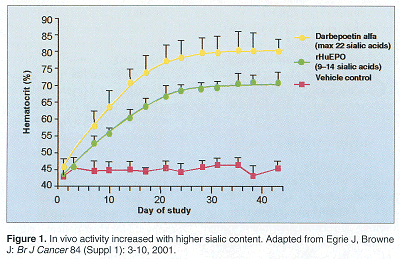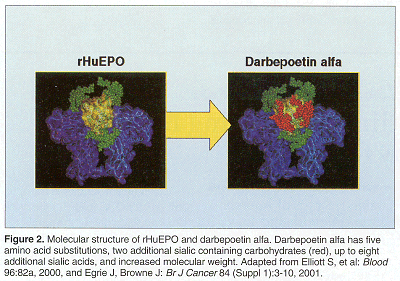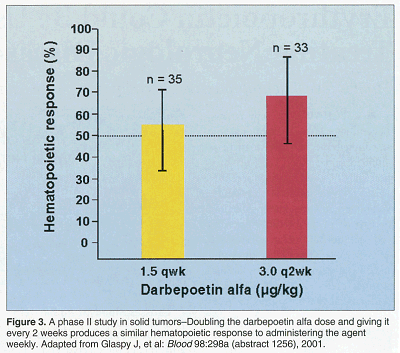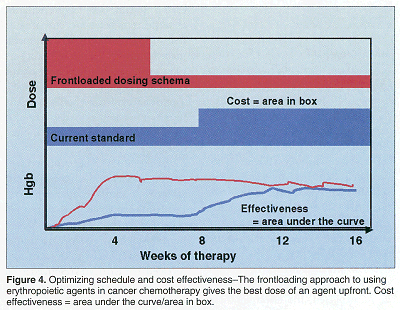Investigator Outlines Stumbling Blocks to Optimal Therapy for Anemia
LOS ANGELES-Many, if not most, oncologists agree that erythropoietic therapy can lower the need for transfusions and improve quality-of-life. This is especially true when cancer patients who suffer from fatigue have their hemoglobin levels raised from 10 g/dL or less to 12 g/dL or more. Why then are less than 30% of patients who should receive erythropoietic therapy being treated with it? (See Table 1.)

LOS ANGELESMany, if not most, oncologists agree that erythropoietic therapy can lower the need for transfusions and improve quality-of-life. This is especially true when cancer patients who suffer from fatigue have their hemoglobin levels raised from 10 g/dL or less to 12 g/dL or more. Why then are less than 30% of patients who should receive erythropoietic therapy being treated with it? (See Table 1.)
There are several reasons for this (if reimbursement were not an issue), according to John A. Glaspy, MD, MPH, of the University of California School of Medicine in Los Angeles.
- The significant numbers of non-responders blunt enthusiasm for erythropoietic therapy in the oncology community and weaken its cost-effectiveness as a treatment strategy.
- Physicians may not be receptive to quality of life as an endpoint.
- Erythropoietic therapy has not always been easy to administer.
Recombinant human erythropoietin (rHuEPO) is made up of several isoforms that differ in the number of glycosylation sites and sialic acids present, from 9 to 14. The greater the number of sialic acid molecules present in an isomer, the greater the potency of the agent in vivo (see Figure 1).

"That led to an effort that spanned years, through site-directed mutagenesis, to develop new erythropoietin genes that added glycosilation sites," Dr. Glaspy explained. "That search ended in darbepoetin alfa (Aranesp), which has two additional glycosylation sites and up to eight additional sialic acids (see Figure 2). So instead of a maximum of 14, there are a maximum number of 22 that are added to the protein." Compared to rHuEPO, darbepoetin alfa is more potent in vivo.

Defining Terms
Meaningful comparison of study results requires agreement on how outcomes are defined.
Hemoglobin response is defined as a hemoglobin increase greater than 2 g/dL (from baseline) in the absence of red blood cell transfusions within the preceding 28 days. But what about a baseline hemoglobin of 11 that rose to 12? Although that gain would put the hemoglobin at a normal level, it didn’t fit the definition of a hemoglobin response because the hemoglobin level only rose 1 g/dL. That change is classified as a hemoglobin correction, defined as hemoglobin greater than 12 g/dL in the absence of red blood cell transfusions within the preceding 28 days. Together, the hemoglobin response and the hemoglobin correction can be used to calculate the hematopoietic response, defined as a hemoglobin increase greater than 2 g/dL (from baseline) or hemoglobin greater than or equal to 12 g/dL. The mean change in hemoglobin refers to the mean change from baseline, in the absence of any red blood cell transfusion within the previous 28 days.
Determining Doses
In a European study, lung cancer patients were randomized to receive either 2.25 µg/kg/week of darbepoetin alfa or a placebo, with the endpoint being need for transfusion. The hematopoietic response rate was 66% and transfusion risk was reduced. "That study is forming the basis for an application in the United States and in Europe for the approval of darbepoetin alfa for patients with cancer receiving chemotherapy," Dr. Glaspy said.
In the United States, "there were a whole series of studies done of increasing doses of darbepoetin alfa in order to gain a thorough understanding of the dose response curve, initially with weekly dosing, using recombinant human erythropoietin, epoetin alfa (Epogen, Procrit), as the control group," Dr. Glaspy said.
"We found with darbepoetin alfa given weekly that there was a clear relationship between dose and hematologic response, with the peak response seeming to occur at 4.5 µg/kg/wk," he said. That dose produced a more rapid response than other doses of darbepoetin alfa or the response with epoetin alfa given 3 times weekly with a dose increase at 8 weeks.
Doubling the darbepoetin alfa dose and giving it every 2 weeks instead of weekly did not cause a decrease in response, Dr. Glaspy said. "There does not seem to be a need to increase the total dose when one goes to every other week." (See Figure 3).

Other studies in Europe, Asia, and Australia tested darbepoetin alfa given every 3 weeks in a placebo controlled trial in patients receiving chemotherapy. The results showed that "every 3 weeks is going to be a viable approach to using darbepoetin alfa in cancer patients," Dr. Glaspy said. "Clearly it produces a response."
Frontloading Approach
The traditional approach to using erythropoietic agents in cancer chemotherapy is to start with a dose that will not elicit responses from all who will eventually respond and then to increase that dose after a period of time to capture nonresponders. That approach, however, means giving the full 12 to 16 weeks of treatment to some people who will never respondabout 30% of patients. "I’ve wondered for awhile whether to give the best dosenot the mediocre dose, but the best doseof an agent up-front, with rapid removal of nonresponders from treatment. Then for those who respond quickly, tapering the dose," Dr. Glaspy said. "For darbepoetin alfa, this might involve 4.5 µg/kg a week, tapering to 4.5 µg/kg every 3 weeks once the patients have responded." That could reduce costs while providing more benefits to some patients (see Figure 4). Preclinical work with mice showed some evidence supporting that dosing strategy for darbepoetin alfa.

In a pilot study, ‘‘patients were randomized to get three different frontloaded darbepoetin alfa regimens, all involving 4.5 µg/kg/wk in the initial phase, with different approaches to maintenancecontinuing the high dose until a response, stopping after 4 weeks and switching to 2.25 µg/kg/wk, or stopping and switching to 1.5 µg/kg/wk, in order to see what the most cost effective of the regimens might be," Dr. Glaspy explained. Patients in the epoetin alfa groups received it in the usual backloaded schedule.
The results showed a higher hemoglobin response rate in the darbepoetin alfa cohorts and improved time to response in at least two of the cohorts. "Epoetin alfa performed the way it had performed in previous analysesit produced its response but it was sluggish," Dr. Glaspy said.
"What was interesting to us was the quality-of-life data," he continued. Stressing that the data were very preliminary, he said that the patients who received "the fastest approach to improving hemoglobin enjoyed a higher quality of life on the Functional Assessment of Cancer Therapy-Fatigue Scale throughout the study, compared to the backloaded epoetin alfa approach."
Oncology Peer Review On-The-Go: Cancer-Related Fatigue Outcome Measures in Integrative Oncology
September 20th 2022Authors Dori Beeler, PhD; Shelley Wang, MD, MPH; and Viraj A. Master, MD, PhD, spoke with CancerNetwork® about a review article on cancer-related fatigue published in the journal ONCOLOGY®.